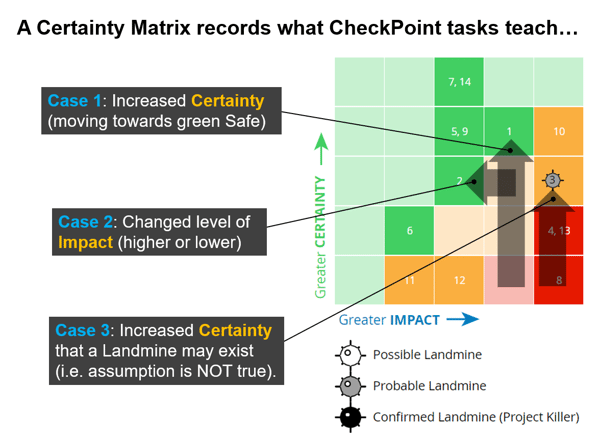Your CheckPoint plan is an action plan for driving key project assumptions from uncertainty to certainty.
Once your team has reviewed its Certainty Matrices, it pursues a CheckPoint plan to investigate those assumptions critical to project success: the red “Danger” and yellow “Caution” assumptions. The CheckPoint plan allows your team to make task assignments for “who does what by when.” So in this regard, you can think of your CheckPoint plan as an “action plan.”
The CheckPoint plan is usually built at the end of the same one-to-two day team meeting in which your project assumptions were generated and rated for impact and certainty. But it could be created at a separate, subsequent meeting.
After the CheckPoint plan is created, your team will review the results of these investigative CheckPoint tasks at regularly scheduled “checkpoints” or team meetings. It’s important for your team to commit to a regular cadence of CheckPoint meetings, e.g. every two weeks.
When your team has a CheckPoint meeting, team members report what they learned as they completed their investigative tasks… such as running a lab experiment, meeting with an industry expert or interviewing a customer. There are three possible outcomes of these task, each of which is reported on a Certainty Matrix.

- Increased certainty towards “Safe.” This is the most common: An assumption moves up on the Certainty Matrix from a red Danger zone or yellow Caution zone to the green Safe zone. It could “make the leap” from red to green when a single CheckPoint task is completed… or it could require several tasks, each of which increases certainty to a smaller degree: Perhaps several meetings with industry experts are needed to reach sufficient certainty, for instance.
- Changed level of Impact. Another possibility is that the investigative task has taught the team that its initial assessment of impact was wrong. So the assumption might move to the left or right on the Certainty Matrix. This could also change the red-yellow-green status of an assumption.
- Increased certainty of a “Landmine.” In this case, the task helped the team learn more about an assumption: They increased their certainty on an assumption that “must be true” for their project to succeed. But unfortunately, they learned that the assumption is NOT true. The team might initially classify this as a “Possible Landmine”… then a “Probable Landmine”… and finally a “Confirmed Landmine” (which kills the project or forces a major project redirect).
In all cases, the team should update its “Source of Truth” and “Findings” on the assumption rating page as it learns more.
Keywords: CheckPoint plan, CheckPoint tasks, investigative tasks, Certainty Matrix, 3 cases, increased certainty, possible landmine, probable landmine, confirmed landmine, Source of Truth, Findings
